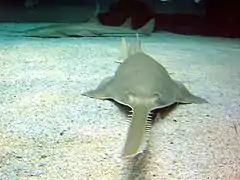Species at Risk Act
The Species at Risk Act (SARA) (the Act) is a piece of Canadian federal legislation which became law in Canada on December 12, 2002. It is designed to meet one of Canada's key commitments under the International Convention on Biological Diversity. The goal of the Act is to protect endangered or threatened organisms and their habitats.[1] It also manages species which are not yet threatened, but whose existence or habitat is in jeopardy.

SARA defines a method to determine the steps that need to be taken in order to help protect existing relatively healthy environments, as well as recover threatened habitats, although timing and implementation of recovery plans have limitations.[1] It identifies ways in which governments, organizations, and individuals can work together to preserve species at risk and establishes penalties for failure to obey the law.
The Act designates COSEWIC, an independent committee of wildlife experts and scientists, to identify threatened species and assess their conservation status. COSEWIC then issues a report to the government, and the Minister of the Environment evaluates the committee's recommendations when considering the addition of a species to the List of Wildlife Species at Risk.
Recent controversies
In July 2016, the Government of Canada issued an emergency order to stop the development of a 2 km2 area on the South Shore (Montreal), Quebec to protect the Western Chorus Frog, which by 2009 had seen a 90% decrease in its historical range.[2] This action was opposed by the Government of Quebec, who perceived it as an overstepping of provincial jurisdiction.[3]
The emergency order stopped the development of 171 new residences that had been approved by the local municipalities and by the Ministry of Sustainable Development, Environment and Parks (Quebec). 1000 residences are still permitted to be constructed.[4] The original approved plan included 35.5 hectares to be retained for Western Chorus Frog habitat and breeding ponds and for a conservation area. 87 hectares will now be set aside.[5]
References
- Dorey, Katherine; Walker, Tony R. (1 January 2018). "Limitations of threatened species lists in Canada: A federal and provincial perspective". Biological Conservation. 217: 259–268. doi:10.1016/j.biocon.2017.11.018. ISSN 0006-3207. Retrieved 10 May 2020.
- Canada, Environment and Climate Change. "Western chorus frog (Canadian Shield), several populations: emergency protection order - Canada.ca". www.registrelep-sararegistry.gc.ca.
- "Quebec hopping mad over federal intervention to protect frog habitat". 22 June 2016.
- "The tiny frogs that stopped bulldozers: Construction halted on Quebec development to save them". 23 June 2016.
- "Western Chorus frogs in La Prairie at the heart of a legal battle". 14 July 2015.

